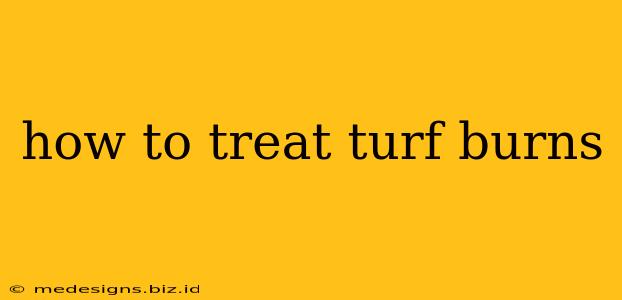Turf burns, those painful abrasions from sliding across grass or other rough surfaces, are a common summertime injury. While often minor, proper treatment is crucial to prevent infection and promote faster healing. This guide provides a step-by-step approach to effectively treat turf burns, ensuring quick recovery and minimizing discomfort.
Understanding Turf Burns
Turf burns are essentially scrapes or abrasions of the skin caused by friction against a rough surface. They range in severity from minor superficial scratches to deeper wounds involving significant skin damage. The severity dictates the treatment approach. Key characteristics include:
- Pain: The level of pain varies depending on the depth and size of the burn.
- Bleeding: Minor bleeding is common, especially with deeper wounds.
- Appearance: The skin may appear red, irritated, and possibly have gravel, dirt, or grass embedded within.
First Aid for Turf Burns: Immediate Actions
The first few hours after a turf burn are critical. Immediate action minimizes the risk of infection and speeds healing. Follow these steps:
1. Cleanse the Wound
Gentle Cleaning is Key: Use cool, clean water to rinse the area thoroughly. Avoid harsh scrubbing, as this can further irritate the wound. Gently remove any visible debris like grass, dirt, or gravel with tweezers if you can see it clearly. Don't try to force anything out if it's deeply embedded.
2. Assess the Severity
Minor vs. Major: Minor turf burns typically involve superficial scrapes with minimal bleeding. Deeper wounds may bleed more profusely and show exposed tissue. Seek medical attention for severe burns, especially if there's significant bleeding, deep wounds, or signs of infection (increased pain, swelling, redness, pus).
3. Apply Antiseptic
Protect Against Infection: After cleaning, apply a thin layer of antibiotic ointment (like Neosporin or Bacitracin) to help prevent infection. This also helps to keep the wound moist, promoting faster healing.
4. Cover the Wound
Protection is Essential: Cover the burn with a sterile bandage or clean cloth to protect it from further irritation and infection. Change the bandage daily or as needed, ensuring the wound remains clean and dry.
Home Treatment for Minor Turf Burns
For minor turf burns, home treatment is usually sufficient. Here's what you should do:
1. Keep it Clean and Dry
Prevent Infection: Keep the area clean and dry to prevent infection. Avoid touching the wound unnecessarily. Change bandages regularly.
2. Avoid Irritants
Gentle Care: Avoid harsh soaps, perfumes, and other irritants that could further irritate the burn.
3. Over-the-Counter Pain Relief
Manage Discomfort: Over-the-counter pain relievers, like ibuprofen or acetaminophen, can help manage any pain or discomfort.
4. Monitor for Signs of Infection
Watch for Warning Signs: Keep a close eye on the wound for signs of infection, such as increased pain, swelling, redness, pus, or fever. Seek medical attention if you notice any of these symptoms.
When to Seek Medical Attention for Turf Burns
While many turf burns heal on their own with proper home care, some require professional medical attention. Seek medical help if:
- Deep wound: The burn is deep, involving significant skin damage.
- Excessive bleeding: You cannot stop the bleeding.
- Signs of infection: The wound shows signs of infection (increased pain, swelling, redness, pus, or fever).
- Embedded debris: You cannot remove deeply embedded debris.
- Large surface area: The burn covers a large area of the skin.
- Underlying injury: You suspect an underlying injury, such as a fracture or tendon damage.
Preventing Turf Burns
Prevention is always better than cure. Here are some tips to minimize your risk of turf burns:
- Wear protective clothing: Wear long pants and long sleeves when playing sports or engaging in activities that increase your risk of turf burns.
- Use protective gear: Use knee pads or elbow pads when participating in activities that involve sliding or falling.
- Be mindful of the surface: Avoid playing or engaging in activities on rough or uneven surfaces.
By following these guidelines, you can effectively treat turf burns and ensure a quick and complete recovery. Remember, prevention is key, so take precautions to avoid these painful abrasions in the first place.
